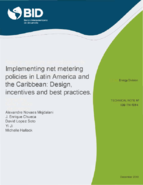Implementing Net Metering Policies in Latin America and the Caribbean: Design, Incentives and Best Practices
Date
Dec 2018
Net Metering (NM) policies have been widely used as a mechanism to allow the inclusion of distributed generation (DG) resources in the energy system, especially the adoption of solar photovoltaic systems by small consumers like households and small business. The core design of NM permits consumers connected to the utility grid to offset consumption by inputting self-generation surplus into the network. The regulatory and policy framework is key to determine the economics of DG (investment costs and benefits), and as a consequence to determining the adoption potential. In Latin America and Caribbean, 16 countries adopted some kind of NM regulation and policy; however, it varies across countries. We analyze the heterogeneity of the NM models in LAC, the key variables that need to be considered to apply NM regulations and policy, and how it generates economic incentives.




